In this Singapore home, a family bonds over meals in a 3 storey-high patio with a view
A patio was the main bonding place for a large extended family. In their new house, ipli Architects recreates this common space with dramatic flair.
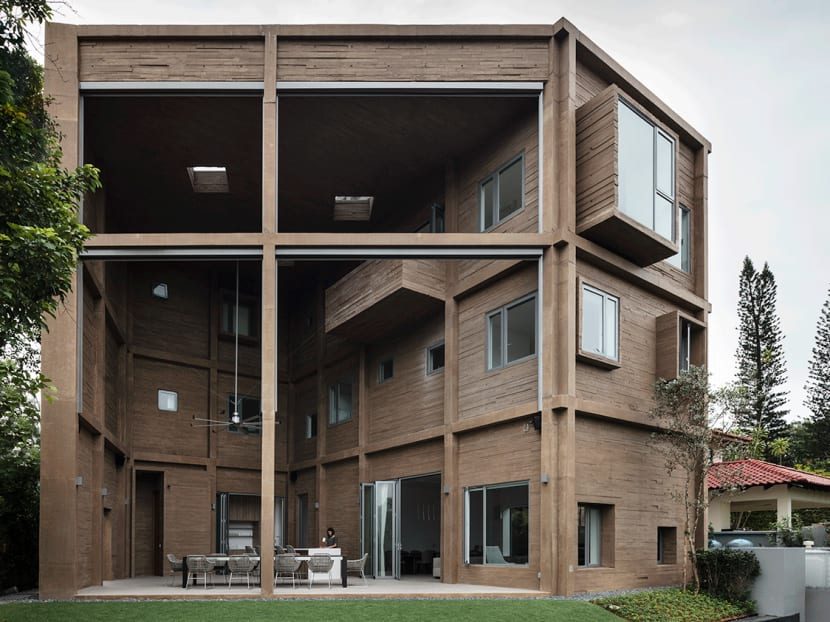
(Photo: Fabian Ong)
Houses designed by ipli Architects are not suited for everyone. Some deem the firm’s preference for raw finishing and dark tones too harsh; others find the monolithic forms that eschew the fanciful decorative elements of quotidian houses unfamiliar.
They are commonly labelled experimental but in actuality, are designed for easy living in the tropics, addressing concerns such as natural ventilation, shade and protection from rain.
The firm, founded in 2001 by architect Yip Yuen Hong and his wife Lee Ee Lin, believes there are different ways of expressing tropical architecture.
One example is this detached house that is located in a landed housing estate in Singapore. From the road, one sees a large box, whose columns have been articulated outwardly to form a gridded pattern on the facade. To the rear, this box has been partially hollowed out into a three-storey-high patio facing a magnificent view of treetops and the city in the distance, thanks to the plot’s elevated terrain.
“The client is a couple who is part of a big household that included their parents, aunts, sister, three children and a domestic helper – all under one roof. Space in the previous house on the same plot, where they had lived for 10 years, was very tight and the couple had to share the room with their children until the reality of them growing up and needing more personal space became unavoidable. So a new house had to be built,” shared Yip.
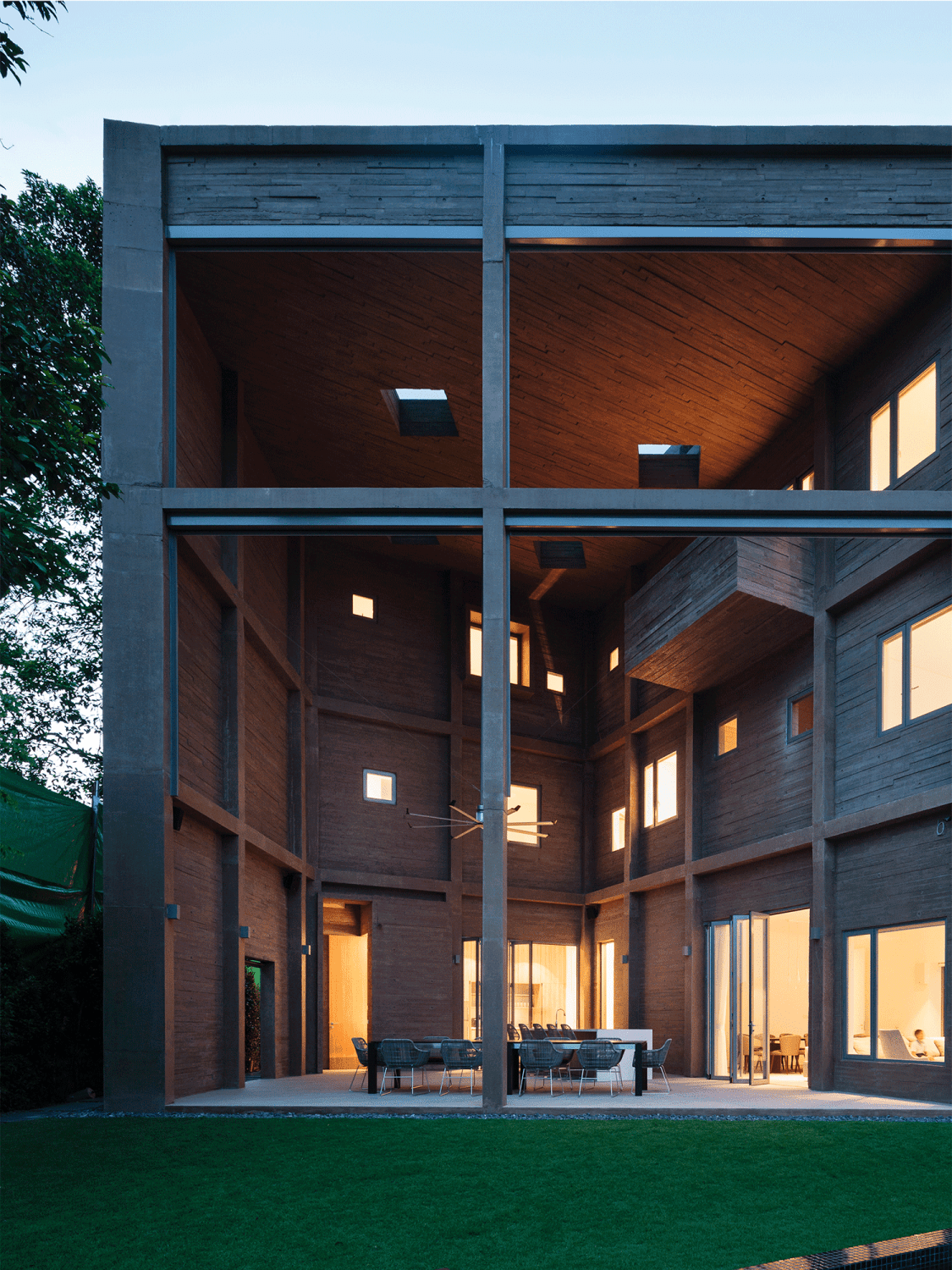
The plot is fan-shaped – narrower at the front and wider at the rear. The spaces are laid out in an L-shape, with rooms looking inward into the patio. Beyond the patio are a small garden, and the swimming pool and deck that were retained from the former house.
“Due to the fantastic view at the rear of the site, the main gathering space for the family should form a dialogue with it,” said Yip on the patio’s placement.
This patio is the most significant part of the house physically and symbolically. “As bedrooms were shared and tight, the family spent most of their time together within the living areas of the previous house – particularly in a small patio that was much loved. Although individual rooms were now to be provided to each member of the new home, it was of utmost importance to the family to be able to continue this deep-rooted habit of spending long quality time together daily,” said Yip.
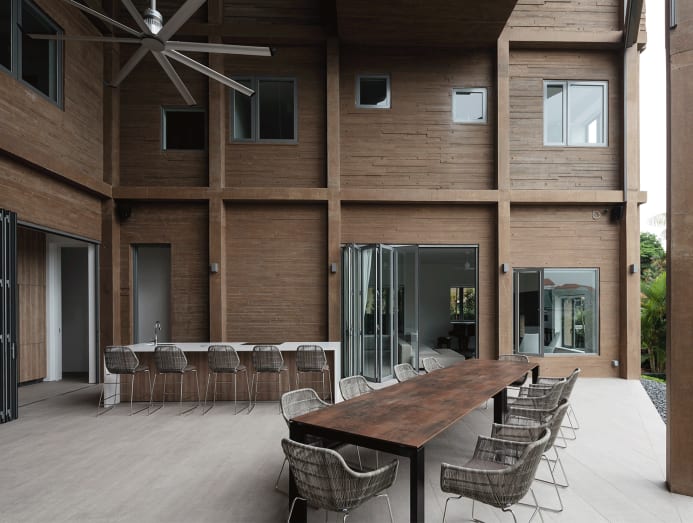
Bedroom windows facing the patio give the occupants privacy from neighbours without sacrificing on views and breeze. “This design enables the rooms and internal spaces to always stay open, letting in wind through the covered patio and affecting natural ventilation,” Yip explained.
All the rooms have at least two windows – one facing the exterior and one facing the patio – that enable cross ventilation even when doors are closed. “Windows on the external facades are set into niches so that they’re protected from the rainwater even if the occupants forget to close them during heavy rains,” Yip commented on the sensible thinking behind the design.
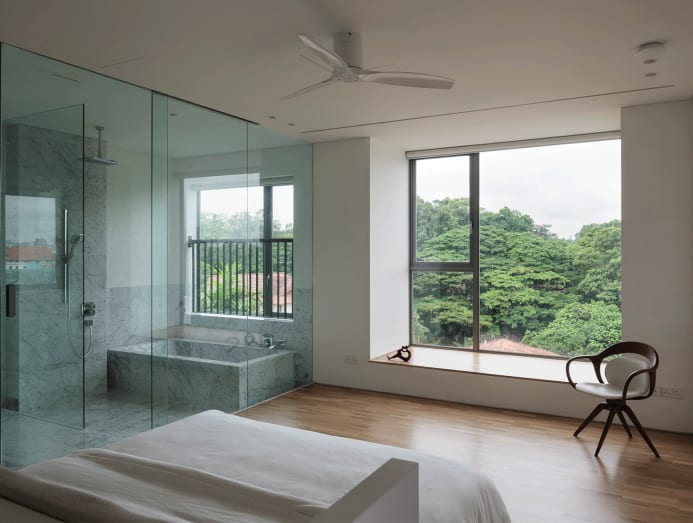
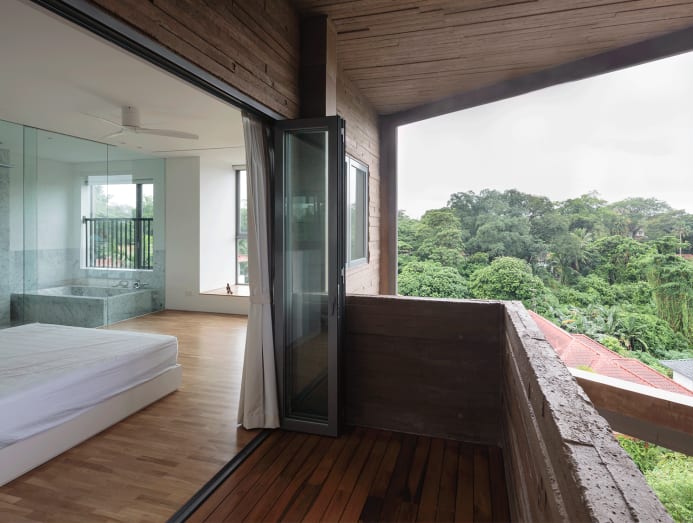
The inward-facing windows also mean that interaction among family members is not limited to the ground storey. “For the family, this creates a focal point in the triple-volume space above the patio through which interactions across different rooms and spaces on all levels can happen effortlessly,” Yip highlighted.
To enhance interaction, he positioned spaces such as the children’s study areas on the third storey and a seating corner along the staircase. This makes it conducive for the occupants to gather in small groups in other parts of the home other than the patio. Another gathering space is the living room, placed at the rear to take advantage of the good view. Slide-fold doors make access between this space and the patio seamless.
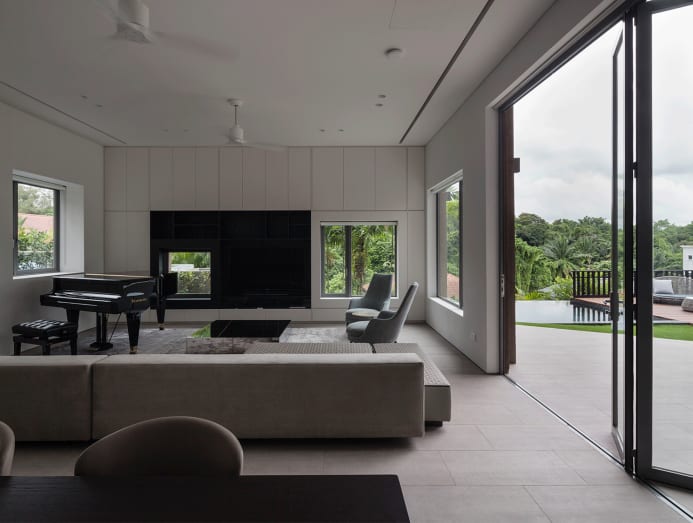
The wife shared that one of the family’s favourite activities is weekend dinners and barbeques on the patio, especially when her husband is the chef. “Gatherings with friends and family are usually held here. It is a unique location where we can continue to enjoy al fresco dinners and barbeques even through a tropical thunderstorm!” she mused. Retractable screens are an additional climatic buffer while four square-shaped skylights puncture the roof, illuminating the space even more.
While space used to be lacking, each family member now enjoys his or her own private zone. The bedrooms of the grandparents and an aunt (another aunt and the client’s sister no longer lives here) are on the second storey while the couple and their children take the entire third storey. At the rooftop is a sheltered study area where the couple spend most evenings. “It has its own balcony overlooking the unblocked views that we enjoy,” shared the wife.

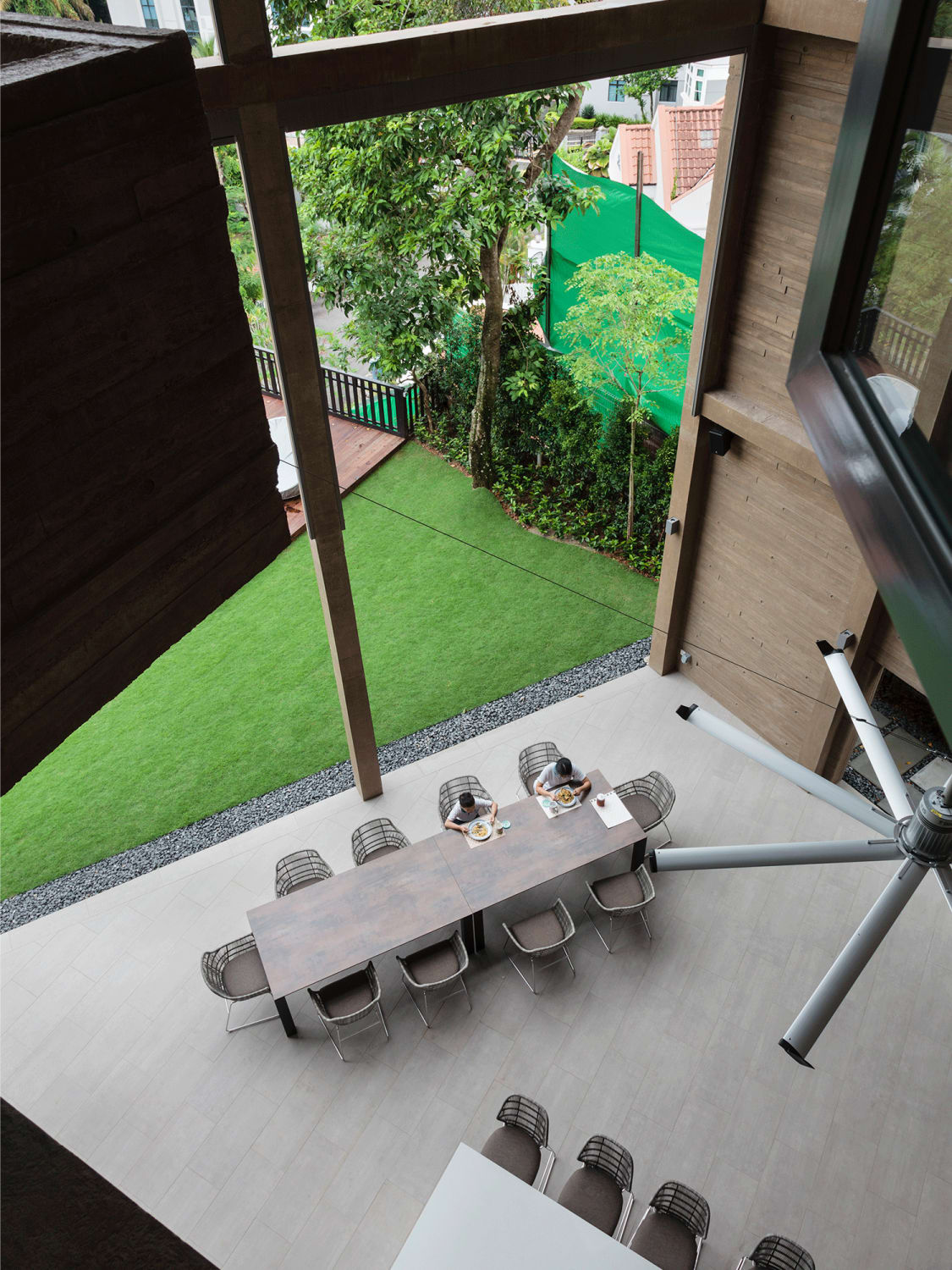
Another interesting aspect of the design is the house’s material and colour. The firm frequently employs off-form concrete in its raw, ashen finishing, but here it has been given a tawny colour. “As the client prefers timber and earth tones, concrete in timber texture with colour treatment was proposed for low maintenance but still achieving a warm feeling,” said Yip, adding, “We see off-form concrete as a suitable material that would weather beautifully, slowly rendering a timeless patina over the architecture.”
The articulation of the columns on the facade was logic-driven. “The external and internal walls are only 150mm thick while the columns are 250mm thick. By transferring the expression outside, I would have a smooth surface on the inside spaces. This makes it easier to place furniture against walls. As there are many rooms to accommodate the large family, they are small so every internal space needs be efficient and usable,” Yip explained. Square windows seemingly placed at random animate the facade.
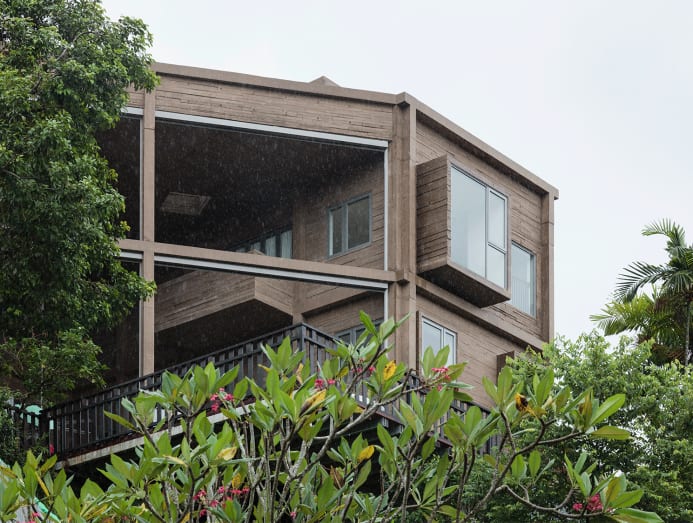
On the interiors, a simple and sleek palette dominates. Light tones and warm materials such as timber flooring and a timber laminate-clad staircase contrast with the rugged external façade. The latter sculpts its way up three storeys as a focal point within the white internal canvas.
While the family still enjoys spending time together, each member has also come to find their own favourite corners of the house. “When the children are not in the privacy of their own rooms busy on their gadgets, they use the different spaces according to their interests. Our 19-year-old daughter enjoys swimming in the pool, our 17-year-old daughter enjoys playing the piano in the first storey living area while the youngest son enjoys spending time in the family area with the grandparents watching whatever is on television,” shared the wife.
Her parents, now retired, also enjoy the house, its views and the good breezes. “Their favourite spots would be at the family area on the floor that looks out into its own garden, as well as the first storey patio,” the wife commented.
After living here for a few years, she needs no convincing of the house’s advantages. “I have come to appreciate how the architecture is simple yet bold at the same time – simple in its use of materials and its aim to give the inhabitants a comfortable home; bold in its unique design, which takes into consideration the site of the house, making full use of the beautiful, unblocked views for the family’s enjoyment whilst offering privacy when needed.”







